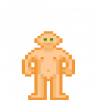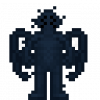Playable Species

|
Stub
Looks like the article engineers are still writing this page. This page is a stub, meaning it is incomplete and/or lacking information. |
There are currently 7 playable species in Space Station 14 - Humans, Reptilians, Slimes, Diona, Dwarves, Arachnids, and Moths. Each has their own distinct stats, strengths, and weaknesses, but all have a few things in common:
- all species are capable of equipping the same tools and items.
- all species are capable of metabolizing reagents and experiencing their effects.
- all species speak the same language.
- all species are to be treated equally by the crew and AI onboard.
NOTE: "Damage Modifiers" refers to TAKEN damage, not damage dealt to other entities.
Humans
Baseline, unmodified human beings, functionally similar to the human beings of our world, aside for a comparatively incredible resistance to the vacuum of space (a trait shared more or less with all SS14 species). They cannot eat raw meat.
Naming Convention: Common (ex. John Smith)
Body
| Image | Organ | Purpose |
|---|---|---|
| Heart | Determines the efficiency of blood pumping. A healthy heart means a healthier body. | |
| Brain | The center of self, the most important part of any individual. Determines who inhabits and controls the body. | |
| Lungs | Determine the rate of breathing. Unhealthy lungs may result in the body getting less O2/N2 than it needs. | |
| Stomach | Aids in the digestion of foods, liquids, and reagents in the body. | |
| Kidneys | Filter the vital fluids of any toxins they might contain. | |
| Liver | Contains enzymes that aid in certain biological processes. | |
| Eyes | Allow for visual information to be extracted from an organism's environment via light. |
Reptilians
Reptile-like humanoids with sharp claws, tough scales, and an appetite for raw meat. Their unarmed melee attacks do piercing instead of blunt damage due to their claws. For whatever reason, onions, chocolate, coffee and tea are poisonous to them, however they are able to eat most corpses without butchering.
Naming Conventions: Common, Verbal (ex. Eats-The-Mouse)
Damage Modifiers
- Cold: +30%
- Heat: -30%
Body
| Image | Organ | Purpose |
|---|---|---|
| Heart | Determines the efficiency of blood pumping. A healthy heart means a healthier body. | |
| Brain | The center of self, the most important part of any individual. Determines who inhabits and controls the body. | |
| Lungs | Determine the rate of breathing. Unhealthy lungs may result in the body getting less O2/N2 than it needs. | |
| Stomach | Aids in the digestion of foods, liquids, and reagents in the body. Able to digest corpses. | |
| Kidneys | Filter the vital fluids of any toxins they might contain. | |
| Liver | Contains enzymes that aid in certain biological processes. | |
| Eyes | Allow for visual information to be extracted from an organism's environment via light. |
Slimes
Gelatinous human-shaped masses of goo who breath nitrogen instead of oxygen, and exhale nitrous oxide. They are naturally vulnerable to both high and low pressure barotrauma, but their elastic form makes them resistant to blunt damage.
Slimes are almost completely immune to cancer due to the nature of their cellular structure, and cannot get drunk due to a specialized metabolism process that isn't affected by alcohol.
Naming Conventions: Common, Cadwellian (ex. Jon Cadwell)
Damage Modifiers
- Blunt: -40%
- Slash: +20%
- Piercing: +20%
- Cold: +50%
- Poison: -20%
- Cellular: -80%
Body
| Image | Organ | Purpose |
|---|---|---|
| Heart | Determines the efficiency of blood pumping. A healthy heart means a healthier body. | |
| Brain | The center of self, the most important part of any individual. Determines who inhabits and controls the body. | |
| Lungs | Determine the rate of breathing. Unhealthy lungs may result in the body getting less O2/N2 than it needs. | |
| Stomach | Aids in the digestion of foods, liquids, and reagents in the body. | |
| Kidneys | Filter the vital fluids of any toxins they might contain. | |
| Liver | Contains enzymes that aid in certain biological processes. | |
| Eyes | Allow for visual information to be extracted from an organism's environment via light. |
Diona
Tree-like plant people whose bodies react with fertilizer and weed-killing chemicals similar to regular plants. They cannot wear shoes, walk slower than the other races, and have a relatively high resistance to brute-force damage. They also have water instead of blood, and require significantly more water to stay hydrated.
Diona can split into 3 pet-like Nymphs upon death manually, or by being gibbed. The original player take control of the "Brain" nymph (The only one able to talk), and the other two can be taken over by ghosts if given cognizine. If given enough time after splitting a single nymph can reform into a full Diona on it's own. The resultant Diona has a different name, and looses memories from it's death (other perhaps than the need to run away and find safety). Additionally this can change traits such as gender.
A zombified Diona is able to split once dead (or after giving up and returning to body) and the resulting nymphs will be zombified, though unable to reform.
Naming Conventions: Common, Qualia[1] (ex. A Peaceful Sunrise)
Damage Modifiers
- Blunt: -30%
- Slash: -20%
- Heat: +50%
- Shock: +20%
Body
NOTE: Diona have plantlike organs, allowing chemicals such as weed killer and robust harvest to affect their bodies similar to plants.
Ex: Diona can consume robust harvest as a weaker form of omnizine.
| Image | Organ | Purpose |
|---|---|---|
| Heart | Determines the efficiency of blood pumping. A healthy heart means a healthier body. | |
| Diona Brain | The center of self, the most important part of any individual. Determines who inhabits and controls the body. Functionally identical to the other humanoid brains. | |
| Lungs | Determine the rate of breathing. Unhealthy lungs may result in the body getting less O2/N2 than it needs. | |
| Diona Stomach | Aids in the digestion of foods, liquids, and reagents in the body. Due to its plantlike nature, it can digest fertilizers and weedkillers similar to the ways a plant would. Still capable of metabolizing medicine meant for animals. | |
| Kidneys | Filter the vital fluids of any toxins they might contain. | |
| Liver | Contains enzymes that aid in certain biological processes. | |
| Diona Eyes | Allow for visual information to be extracted from an organism's environment via light. Functionally identical to other humanoid eyeballs. |
Dwarves
A stout and stalwart race quite similar to humans, save for their diminutive stature, as well as a propensity for alcohol and goofy Scottish accents. Somehow, alcohol is able to heal their injuries. Their small size makes them easier for most races to shove them over.
Naming Conventions: Common, Scottish, Gaelic (ex. Brian O'Finnegan)
Body
| Image | Organ | Purpose |
|---|---|---|
| Heart | Determines the efficiency of blood pumping. A healthy heart means a healthier body. | |
| Brain | The center of self, the most important part of any individual. Determines who inhabits and controls the body. | |
| Lungs | Determine the rate of breathing. Unhealthy lungs may result in the body getting less O2/N2 than it needs. | |
| Stomach | Aids in the digestion of foods, liquids, and reagents in the body. Somehow capable of metabolizing alcohol as a healing agent(?) | |
| Kidneys | Filter the vital fluids of any toxins they might contain. | |
| Liver | Contains enzymes that aid in certain biological processes. | |
| Eyes | Allow for visual information to be extracted from an organism's environment via light. |
Arachnids
Not to be confused with insectoids, Arachnids cut a striking figure with their pressure-resistant exoskeletons and extra arms. Possibly related to the space spiders and giant tarantulas found in outer space. Thanks to their similarly robust digestive systems, they are able to consume raw food without the risk of disease. They are more vulnerable to asphyxiation and take longer to recover from it.
They have two extra pocket slots formed by webs.
Naming Conventions: Common, Latin (ex. Pluribus Unum)
Body
NOTE: Arachnids have a slower metabolic rate than other organisms (around 50% slower), meaning they heal from medicine and take damage from ingested toxins slower. This has no effect on externally applied reagents, so spilling a acid on an Arachnid will kill them just the same as anyone else.
| Image | Organ | Purpose |
|---|---|---|
| Heart | Determines the efficiency of blood pumping. A healthy heart means a healthier body. | |
| Brain | The center of self, the most important part of any individual. Determines who inhabits and controls the body. | |
| Lungs | Determine the rate of breathing. Unhealthy lungs may result in the body getting less O2/N2 than it needs. | |
| Stomach | Aids in the digestion of foods, liquids, and reagents in the body. Able to digest corpses. | |
| Kidneys | Filter the vital fluids of any toxins they might contain. | |
| Liver | Contains enzymes that aid in certain biological processes. | |
| Eyes | Allow for visual information to be extracted from an organism's environment via light. |
Moths
Moths, meanwhile, actually are an insectoid species. Their wings allow them greater control in zero gravity than other species, and their natural resistance to cold helps greatly in a space environment. The tradeoff, naturally, is that heat is more dangerous.
Naming Convention: Common, (ex. John Doe)
Damage Modifiers
- Cold: -30%
- Heat: +30%
Body
| Image | Organ | Purpose |
|---|---|---|
| Heart | Determines the efficiency of blood pumping. A healthy heart means a healthier body. | |
| Brain | The center of self, the most important part of any individual. Determines who inhabits and controls the body. | |
| Lungs | Determines the rate of breathing. Unhealthy lungs may result in the body getting less O2 than it needs. | |
| Moth Stomach | Aids in the digestion of cloth and reagents in the body. Finds non-cloth foods repulsive. | |
| Kidneys | Filter the vital fluids of any toxins they might contain. | |
| Liver | Contains enzymes that aid in certain biological processes. | |
| Eyes | Allow for visual information to be extracted from an organism's environment via the light. |


















